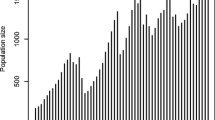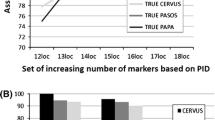Abstract
The male leaders of free-ranging harem groups of hamadryas baboons are believed to mate exclusively with the female members of their harems, which typically contain no more than 2–3 females. Using no-parent parentage exclusion analysis (PEA) we identified the paternity of 25 offspring born in a captive band of hamadryas baboons (Papio hamadryas hamadryas) containing five adult males, each with a stable harem of about five females. Nine of 13 microsatellite (SSR) loci known to be highly polymorphic in rhesus macaques (Macaca mulatta) were successful in identifying the sires of all but two offspring without knowledge of the dams' genotypes, and we were able to determine the sires of all offspring when the dams' genotypes were considered. Mating success of the males ranged between 2 and 7 offspring and bore no clear relationship to the males' ages, ranks or the number of females in their harems. The males sired 7 of the 25 offspring with females outside their own harems, with higher-ranking males exhibiting greater success monopolizing access to females in their harem than lower-ranking males did. More surprisingly, the females assigned as the dams of 14 of the 25 offspring could be unequivocally excluded from parentage. The identity of the true dam could be determined for each of these 14 offspring using single-parent PEA and was uncorrelated with the ranks of these offsprings' sires and whether the offspring were born to dams outside the sires' harem groups. The combined effect of this extraharem mating and kidnapping was that only 12 of the 25 offspring were raised within their sires' harem groups. A second group of hamadryas baboons of identical structure exhibited the same high incidences of infant kidnapping and mating outside the harem group. It is unclear whether these behaviors provide an adaptive advantage or represent aberrant behavior resulting from captivity or other circumstances.
Similar content being viewed by others
REFERENCES
Abegglen, J. J. (1984). On Socialization of Hamadryas Baboons, Associated University Presses, Cranbury, NJ.
Altmann, J., Alberts, S. C, Haines, S. A., Dubach, J., Muruthi, P., Coote, T, Geffen, E., Cheesman, D. J., Mututua, R. S., Saiyalel, S. N., Wayne, R. K., Lacy, R. C., and Bruford, M. W. (1996). Behavior predicts genetic structure in a wild primate group. Proc. Nati. Acad. Sci. 93: 5797–5801.
Bercovitch, F. (1995). Female cooperation, consortship maintenance and male mating success in savanna baboons. Anim. Behav. 50: 137–149.
Biquand, S., Boug, A., Biquand-Guyot, V., and Gautier, J.-P. (1994). Management of commensal baboons in Saudi Arabia. Terre Vie 49: 213–222.
Cowlishaw, G., and Dunbar, R. I. M. (1991). Dominance rank and mating success in male primates. Anim. Behav. 41: 1045–1056.
Ely, J. J., Campbell, M. L., Gonzalez, D. L., and Stone, W. H. (1996). Successful amplification of PCR-amplified DNA markers for paternity determination in rhesus monkeys (Macaca mulatta) and chimpanzees (Pan troglodytes). Lab. Anim. News. 35: 1–4.
Gygax, L. (1995). Hiding behaviour of lion-tailed macaques. I. Theoretical background and data on mating. Ethology 101: 10–24.
Harvey, N. C., DeFalco, K., and Lindburg, D. G. (1994). Night time activities in a captive social group of lion-tailed macaques. Am. J. Primatol. 33: 213.
Holman, S. D., and Goy, R. W. (1995). Experiential and hormonal correlates of caregiving in rhesus macaques. In Pryce, C. R., Martin, R. D., and Skuse, D. (eds.), Motherhood in Human and Nonhuman Primates, Karger, Basel, pp. 87–93.
Kanthaswamy, S., and Smith, D. G. (1998). Use of microsatellite polymorphisms for paternity exclusion in rhesus macaques (Macaca mulatta). Primates 39: 135–145.
Kayser, M., Ritter, H., Bercovitch, F., Mrug, M, Roewer, L., and Nurnberg, P. (1996). Identification of highly polymorphic microsatellites in the rhesus macaque (Macaca mulatta) by cross-species amplification. Molec. Ecol. 5: 157–159.
Kummer, H. (1968). Social Organization of Hamadryas Baboons, University of Chicago Press, Chicago.
Kummer, H., and Kurt, F. (1965). A comparison of social behavior in captive and wild hamadryas baboons. In Vagtborg, H. (ed.), The Baboon in Medical Research, Univ. of Texas Press, Austin, pp. 65–80.
Kummer, H., Gotz, W., and Angst, W. (1974). Triadic differentiation: An inhibitory process protecting pair bonds in baboons. Behaviour 49: 62–87.
Morin, P. A., and Smith. D. G. (1995). Nonradioactive detection of hypervariable simple sequence repeats in short polyacrylamide gels. Biotechniques 19: 223–227.
Morin, P. A., Kanthaswamy, S., and Smith, D. G. (1997). Simple sequence repeat (SSR) polymorphisms for colony management and population genetics in rhesus macaques (Macaca mulatta). Am. J. Primatol. 42: 199–213.
Morin, P. A., Mahboubi, P., Wedel, S., and Rogers, J. (1998). Rapid screening and comparison of human microsatellite markers in baboons: Allele size is conserved, but allele number is not. Genomics 53: 12–20.
Nagel, U. (1973). A comparison of hamadryas baboons, anubis baboons, and their hybrids at a species border in Ethiopia. Folia Primatol. 19: 104–165.
Nei, M. (1973). Analysis of gene diversity in subdivided populations. Proc. Nat. Acad. Sci. USA. 70: 3321–3323.
Phillips-Conroy, J. E., Jolly C. J., and Brett, F. L. (1991). Characteristics of hamadryas-like male baboons living in anubis baboon troops in the Awash Hybrid Zone, Ethiopia. Am. J. Phys. Anthropol. 86: 353–368.
Pryce, C. R. (1996). Socialization, hormones and the regulation of maternal behavior in nonhuman simian primates. Adv. Stud. Behav. 25: 423–473.
Schwibbe, M., Zinner, D., and Klensang, H. (1992). Factors and effects of the synchronisation of the reproductive cycle of hamadryas baboons Papio hamadryas (Abstracts). Congress of the International Primatotogical Society, Strasbourg 14: 315.
Siegal, S., and Castellan, N. J., Jr. (1988). Nonparametric Statistics for the Behavioral Sciences, McGraw-Hill, New York.
Small, M. F. (1989). Female choice in nonhuman primates. Yrbk. Phys. Anthropol. 32: 103–127.
Smith, D. G. (1994). Genetic heterogeneity in five captive specific pathogen-free groups of rhesus macaques. Lab. Anim. Sci. 44: 200–210.
Stammbach, E. (1987). Desert, forest and montane baboons: Multilevel-Societies. In Smuts, B. B., Cheney, D. L., Seyfarth, R. M., Wrangham, R. W., and Struhsaker, T. T. (eds.), Primate Societies, The University of Chicago Press, Chicago, pp. 112–120.
Stern, B. R., and Smith, D. G. (1984). Sexual behaviour and paternity in three captive groups of rhesus monkeys (Macaca mulatta). Anim. Behav. 32: 23–32.
St. George, D., Witte, S. M., Turner, T. R., Weiss, M. L., Phillips-Conroy, J., Smith, E. O., and Rogers, J. (1998). Microsatellite variation in two populations of free-ranging yellow baboons (Papio hamadryas cynocephalus). Inter. J. Primatol. 19: 273–285.
Zinner, D., Schwibbe, M. H., and Kaumanns, W. (1994). Cycle synchrony and probability of conception in female hamadryas baboons Papio hamadryas. Behav. Ecol. Sociobiol. 35: 175–183.
Zuckerman, S. (1932). The Social Life of Monkeys and Apes, Kegan Paul, London.
Author information
Authors and Affiliations
Rights and permissions
About this article
Cite this article
Smith, D.G., Kanthaswamy, S., Disbrow, M. et al. Reconstruction of Parentage in a Band of Captive Hamadryas Baboons. International Journal of Primatology 20, 415–429 (1999). https://doi.org/10.1023/A:1020504905350
Issue Date:
DOI: https://doi.org/10.1023/A:1020504905350




